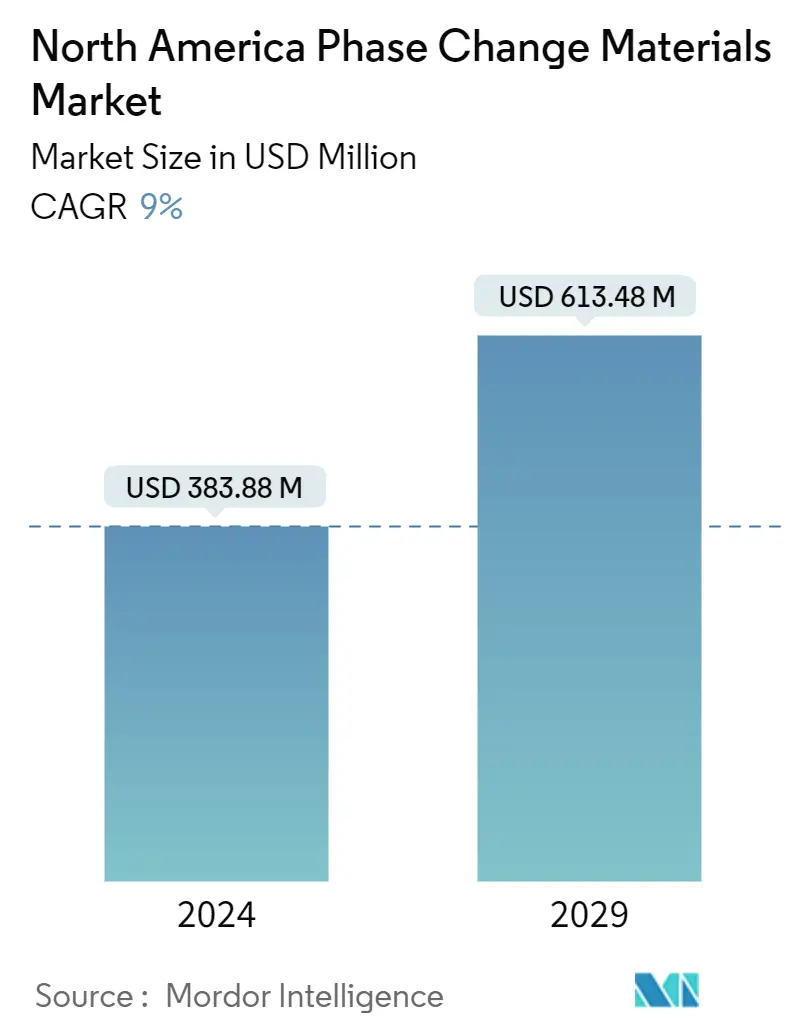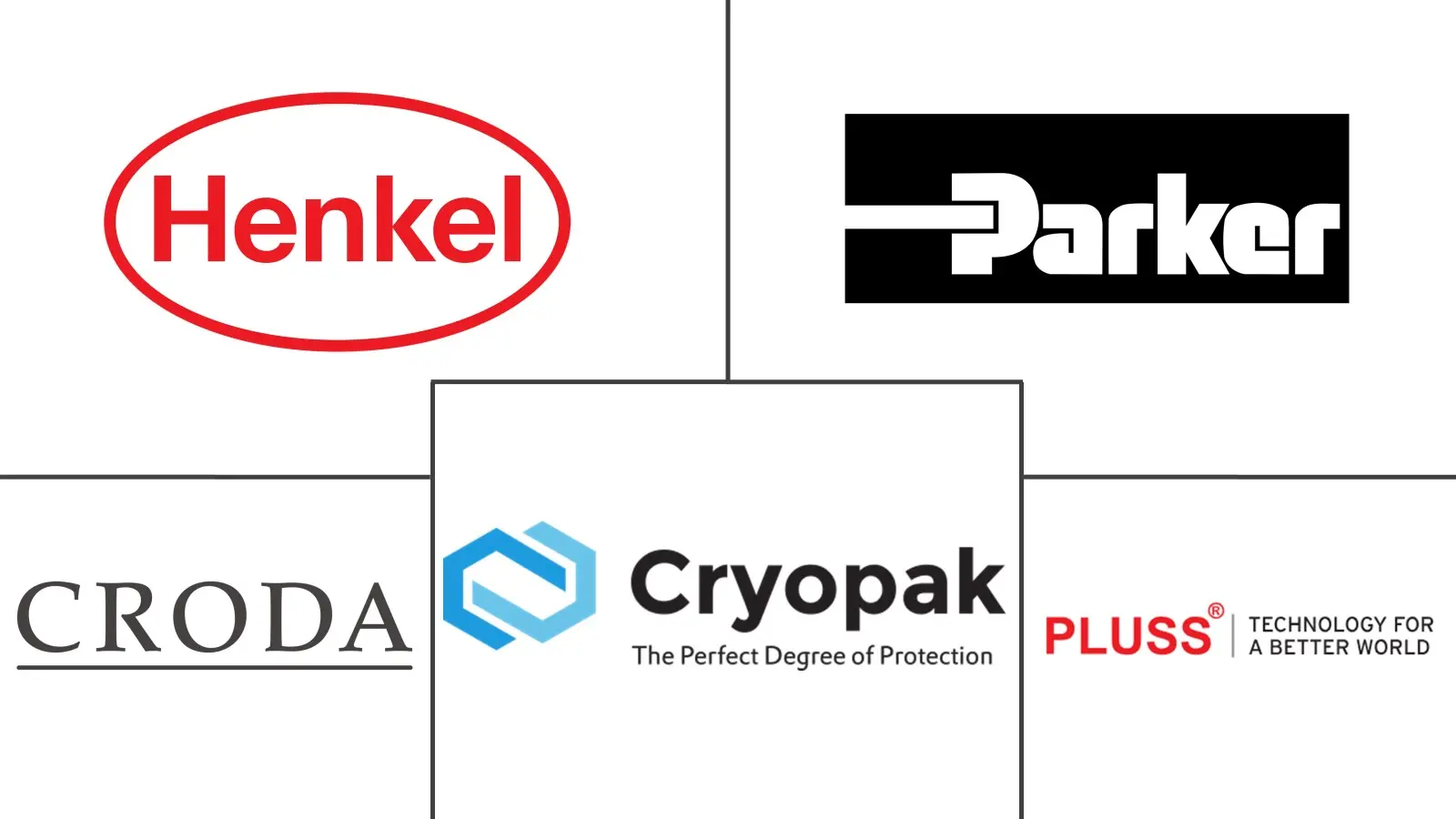Market Size of North America Phase Change Materials Industry

| Study Period | 2019-2029 |
| Base Year For Estimation | 2023 |
| Market Size (2024) | USD 383.88 Million |
| Market Size (2029) | USD 613.48 Million |
| CAGR (2024 - 2029) | 9.00 % |
| Market Concentration | Medium |
Major Players
*Disclaimer: Major Players sorted in no particular order |
North America Phase Change Materials Market Analysis
The North America Phase Change Materials Market size is estimated at USD 383.88 million in 2024, and is expected to reach USD 613.48 million by 2029, growing at a CAGR of 9% during the forecast period (2024-2029).
The phase change materials market was disrupted due to COVID-19 in North America. Lockdowns, restrictions, and disruptions in transportation networks led to challenges in the supply chain. This affected the availability of raw materials and components for PCM manufacturing. Post-pandemic, there was a renewed emphasis on sustainable practices and energy efficiency in building design. PCMs, known for their ability to regulate temperature and reduce energy consumption in HVAC systems, gained renewed attention, driving market recovery.
Increasing focus on sustainability and energy conservation in building and construction and growing demand from the electronics industry are expected to drive the phase change materials market in North America.
However, the hazardous nature of several phase change materials is expected to restrain the market studied.
The development of phase change thermal interface material and rising awareness of bio-based phase change materials are expected to provide opportunities to market players for the market studied.
The United States is likely to dominate the market during the forecast period.
North America Phase Change Materials Industry Segmentation
A phase change material is a substance that releases/absorbs sufficient energy at phase transition to provide helpful heat/cooling. PCMs can provide district cooling and thermal buffer swings in buildings and store solar thermal energy for short-term or seasonal applications.
North America's phase change materials market is segmented by product type, end-user industry, and geography (United States, Canada, and Mexico). By product type, the market is segmented into organic, inorganic, and bio-based products. End-user industry segmentation includes building and construction, packaging, textiles, electronics, transportation, and other end-user industries (renewable, healthcare). The report also covers the market size and forecasts for the North American phase change materials market in 3 countries across the region.
For each segment, the market sizing and forecasts have been done on the basis of value (USD).
| Type | |
| Organic | |
| Inorganic | |
| Bio-based |
| End-User Industry | |
| Building and Construction | |
| Packaging | |
| Textiles | |
| Electronics | |
| Transportation | |
| Other End-User Industries (Renewables, Healthcare) |
| Geography | |
| United States | |
| Canada | |
| Mexico |
North America Phase Change Materials Market Size Summary
The North America phase change materials market is poised for significant growth, driven by an increasing emphasis on sustainability and energy efficiency in building designs. The market, which experienced disruptions due to the COVID-19 pandemic, is recovering as PCMs gain attention for their ability to regulate temperature and reduce energy consumption in HVAC systems. The construction industry, particularly in the United States and Canada, is a major driver of this market, with phase change materials being utilized in various applications such as under-floor heating systems, PCM-filled glass windows, and thermally efficient concrete. Despite challenges posed by the hazardous nature of some PCMs, the development of bio-based alternatives and thermal interface materials presents new opportunities for market players.
The demand for phase change materials is expected to rise as the construction sector continues to expand, with increased investments in both residential and non-residential projects across North America. The market is characterized by a moderate pace of growth, supported by the ongoing trend towards green building practices and the optimization of energy systems in buildings. Key players in the market, including Henkel AG & Co. KGaA, Croda International Plc, and Parker Hannifin Corp, are actively innovating and launching new products to meet the growing demand. As the market landscape remains partially fragmented, these companies are well-positioned to capitalize on the opportunities presented by the increasing adoption of phase change materials in various industries.
North America Phase Change Materials Market Market Size - Table of Contents
-
1. MARKET DYNAMICS
-
1.1 Market Drivers
-
1.1.1 Increasing Focus on Sustainability and Energy Conservation in Building and Construction
-
1.1.2 Growing Demand From Electronics Industry
-
1.1.3 Other Drivers
-
-
1.2 Market Restraints
-
1.2.1 Hazardous Nature of Several Phase Change Materials
-
1.2.2 Other Restraints
-
-
1.3 Industry Value Chain Analysis
-
1.4 Porter's Five Forces Analysis
-
1.4.1 Bargaining Power of Suppliers
-
1.4.2 Bargaining Power of Buyers
-
1.4.3 Threat of New Entrants
-
1.4.4 Threat of Substitute Products
-
1.4.5 Degree of Competition
-
-
-
2. MARKET SEGMENTATION (Market Size in Value)
-
2.1 Type
-
2.1.1 Organic
-
2.1.2 Inorganic
-
2.1.3 Bio-based
-
-
2.2 End-User Industry
-
2.2.1 Building and Construction
-
2.2.2 Packaging
-
2.2.3 Textiles
-
2.2.4 Electronics
-
2.2.5 Transportation
-
2.2.6 Other End-User Industries (Renewables, Healthcare)
-
-
2.3 Geography
-
2.3.1 United States
-
2.3.2 Canada
-
2.3.3 Mexico
-
-
North America Phase Change Materials Market Market Size FAQs
How big is the North America Phase Change Materials Market?
The North America Phase Change Materials Market size is expected to reach USD 383.88 million in 2024 and grow at a CAGR of 9% to reach USD 613.48 million by 2029.
What is the current North America Phase Change Materials Market size?
In 2024, the North America Phase Change Materials Market size is expected to reach USD 383.88 million.

